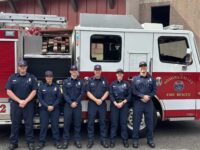For the fourth time this year, Sonoma Valley firefighters have been dispatched as part of a statewide force – this time, to the Telegraph Fire near Yosemite.
Sonoma Valley Fire and Rescue Authority Capt. Sean Lacy, Engineer Medic Les Bender, and firefighters Jack Ayers and Eric Padgett left for a seven-day assignment at around 3:30 p.m. Sunday in the department’s California Office of Emergency Services engine, SVFRA Division Chief John Franceschi said.
The OES maintains a cadre of engines and crews throughout California, including one in Sonoma Valley. The truck, dubbed “OES-319,” is part of a strike team of four other engines from Santa Rosa, Benicia, Georgetown and El Dorado County, SVFRA Capt. Spencer Andreis said Tuesday.
He added that the crews are “working 24-hour shifts with little rest on their days off.”
The Telegraph Fire began Friday afternoon, and had burned more than 30,000 acres of steep terrain with only 10 percent containment as of press time. Twenty-five homes and 27 other structures had been destroyed and 2,000 others threatened by the blaze, which was reportedly caused by someone target shooting.
Sonoma’s OES engine got its first taste of smoke this year on May 22, when crews responded to the week-long Summit Fire near Santa Cruz. On June 11, it headed to Chico for six days, then returned to Butte County on June 22 for 25 days to help fight a series of lightning-struck fires still being contained by firefighters from the western United States and several foreign countries.
Franceschi said it usually takes at least a day to scrub down the truck and get it ready for redeployment, noting that “3382” – one of SVFRA’s local engines that was also battling the Northern California Lightning Series, and broke a suspension system doing so – required two entire shifts to make ready.
“They get used hard on those strike teams,” Franceschi said.
California’s fire season began June 2 – the date Cal Fire announced that its own statewide firefighting mechanism was fully staffed and ready for action. Asked whether or not it’s typical for the OES engine to see this much duty, Andreis was blunt.
“No,” he said. “This year has started very early and the frequency of deployment is very unusual.”
Yosemite blaze gets Valley help
More from What's HappeningMore posts in What's Happening »




